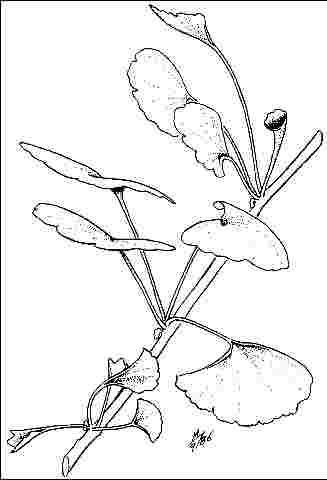Introduction
This male cultivar of Ginkgo is practically pest-free, resistant to storm damage, and casts dense shade. It makes a durable street tree especially where overhead vertical space limits selection of wide trees. The shape is a symmetrical pyramid growing about 50 feet tall and 20 to 25 feet wide, which is quite unlike the open spreading habit of the species. There are other narrow, upright cultivars such as ‘Princeton Sentry' and ‘Fairmont'. Ginkgo tolerates most soil, including compacted, and alkaline. The tree is easily transplanted and has a vivid yellow fall color which is second to none in brilliance, even in the south. However, leaves fall quickly, and the fall color show is short. Unlike the species, the tree does not set fruit.

Credit: Ed Gilman, UF/IFAS
General Information
Scientific name: Ginkgo biloba
Pronunciation: GINK-go bye-LOE-buh
Common name(s): 'Lakeview' maidenhair tree, ‘Lakeview' ginkgo
Family: Ginkgoaceae
USDA hardiness zones: 3A through 8A (Figure 2)
Origin: not native to North America
Invasive potential: not assessed/incomplete assessment
Uses: sidewalk cutout (tree pit); street without sidewalk; urban tolerant; highway median; tree lawn > 6 ft wide; Bonsai; tree lawn 4–6 feet wide

Credit: UF/IFAS
Description
Height: 50 to 60 feet
Spread: 20 to 30 feet
Crown uniformity: symmetrical
Crown shape: upright/erect, pyramidal
Crown density: dense
Growth rate: slow
Texture: medium
Foliage
Leaf arrangement: alternate (Figure 3)
Leaf type: simple
Leaf margin: lobed
Leaf shape: fan-shaped
Leaf venation: parallel, palmate
Leaf type and persistence: deciduous
Leaf blade length: 2 to 4 inches
Leaf color: green
Fall color: yellow
Fall characteristic: showy

Credit: UF/IFAS
Flower
Flower color: green
Flower characteristics: not showy
Fruit
Fruit shape: no fruit
Fruit length: no fruit
Fruit covering: no fruit
Fruit color: no fruit
Fruit characteristics: no fruit
Trunk and Branches
Trunk/bark/branches: branches droop; showy; typically one trunk; thorns
Pruning requirement: little required
Breakage: resistant
Current year twig color: brown, gray
Current year twig thickness: medium, thick
Wood specific gravity: unknown
Culture
Light requirement: full sun, partial sun, or partial shade
Soil tolerances: sand; loam; clay; acidic; alkaline; well-drained; occasionally wet
Drought tolerance: high
Aerosol salt tolerance: moderate
Other
Roots: not a problem
Winter interest: yes
Outstanding tree: yes
Ozone sensitivity: unknown
Verticillium wilt susceptibility: resistant
Pest resistance: free of serious pests and diseases
Use and Management
Ginkgo may grow extremely slow for several years after planting but will then pick up and grow at a moderate rate, particularly if it receives an adequate supply of water and some fertilizer. But do not overwater or plant in a poorly drained area. Keep turf away from several feet around the trunk to help the tree become established. Very tolerant of urban soils and pollution, Ginkgo could be used more in USDA hardiness zone 7 but is not recommended in central and southern Texas or Oklahoma due to summer heat. Adapted for use as a street tree, even in confined soil spaces. Some early pruning to form one central leader and to eliminate vigorous upright branches is helpful.
There are several cultivars: ‘Autumn Gold'—male, fruitless, bright gold fall color and rapid growth rate; ‘Fairmont'—upright, oval to pyramidal form; ‘Fastigiata'—male, fruitless, upright growth; ‘Laciniata'—leaf margins deeply divided; ‘Mayfield'—male, fruitless, upright fastigiate (columnar) growth; ‘Pendula'—pendent branches; ‘Princeton Sentry'—male, fruitless, fastigiate, narrow conical crown for restricted overhead spaces, popular, 65 feet tall, available in some nurseries; ‘Santa Cruz'—umbrella-shaped, ‘Variegata'—variegated leaves.
Propagation is by seed or grafting males.
Pests and Diseases
This tree is pest-free and considered resistant to gypsy moth.